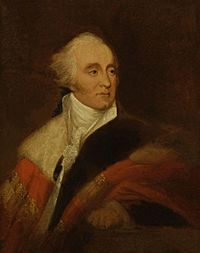Gilbert Elliot-Murray-Kynynmound, 1st Earl of Minto facts for kids
Quick facts for kids
The Earl of Minto
PC, FRSE
|
|
|---|---|

by James Atkinson
|
|
| Governor-General of the Presidency of Fort William | |
| In office 31 July 1807 – 4 October 1813 |
|
| Monarch | George III |
| Preceded by | Sir George Barlow (Acting Governor-General) |
| Succeeded by | The Earl of Moira |
| President of the Board of Control | |
| In office 1806–1806 |
|
| Monarch | George III |
| Preceded by | Viscount Castlereagh |
| Succeeded by | Thomas Grenville |
| Viceroy of the Anglo-Corsican Kingdom | |
| In office 1793–1796 |
|
| Monarch | George III |
| Preceded by | Office established |
| Succeeded by | Office disestablished |
| Personal details | |
| Born |
Gilbert Elliot
23 April 1751 Edinburgh |
| Died | 21 June 1814 (aged 63) Stevenage, Hertfordshire |
| Resting place | Westminster Abbey |
| Nationality | British |
| Spouse |
Anna Maria Amyand
(m. 1777) |
| Children |
|
| Parents |
|
| Alma mater | |
Gilbert Elliot-Murray-Kynynmound, 1st Earl of Minto (born April 23, 1751 – died June 21, 1814) was an important British diplomat and politician. He was known by different titles during his life, including Sir Gilbert Elliott and Lord Minto. He served in the House of Commons, which is part of the British Parliament, from 1776 to 1795.
He also held significant roles overseas. From 1793 to 1796, he was the viceroy of the Anglo-Corsican Kingdom, a short-lived British-controlled state on the island of Corsica. Later, he became the Governor-General of India from 1807 to 1813, a very powerful position.
Contents
Early Life and Education
Gilbert Elliot was born in Edinburgh, Scotland. He was the oldest son of Sir Gilbert Elliot, 3rd Baronet, and Agnes Dalrymple-Murray-Kynynmound. His family had many notable members. For example, his uncle, John Elliott, was a Royal Navy officer and a governor of Newfoundland. Another uncle, Andrew Elliot, was a colonial governor in New York.
Around 1763, Gilbert and his younger brother, Hugh, went to Paris to study. The famous Scottish philosopher David Hume helped supervise their education there. They also became close friends with Honoré Mirabeau, a future leader of the French Revolution. After studying at the University of Edinburgh, Gilbert attended Christ Church, Oxford. He then became a lawyer, which is known as being "called to the Bar" in Britain.
A Career in Politics
In 1776, Gilbert Elliot began his political career. He was elected to Parliament as an independent Whig Member of Parliament (MP) for Morpeth. He became good friends with Edmund Burke, another influential politician. Gilbert helped Burke in his efforts against Warren Hastings, a former Governor-General of Bengal, and Sir Elijah Impey.
Gilbert Elliot tried twice to become the Speaker of the House of Commons. The Speaker is the person who leads the debates in Parliament. However, he was not successful in the elections of January and June 1789.
Serving as Viceroy
In 1793, Gilbert Elliot was made a member of the Privy Council. This is a group of advisors to the British monarch. In 1794, he was appointed as the viceroy of the Anglo-Corsican Kingdom. A viceroy is someone who rules a country or province as the representative of a king or queen. This kingdom on Corsica was under British control for only a short time.
In 1797, he added the names Murray and Kynynmound to his own. He was also given the title Baron Minto. This meant he became a member of the House of Lords, the upper house of the British Parliament.
Leading in India
From 1799 to 1801, Lord Minto served as the British Ambassador to Austria. After a short time as President of the Board of Control, he was appointed Governor-General of India at the end of 1806. His term officially began on July 31, 1807. This was a very important role, as he was in charge of all British territories in India.
During his time as Governor-General, he expanded British influence. He took control of Dutch possessions in the East Indies, such as the Moluccas and Java, during the Napoleonic Wars. These wars involved many European countries. In 1810, he helped free the British explorer Matthew Flinders, who had been held prisoner for six years on the Isle of France (Mauritius). The town of Minto in Australia was named after him in 1809.
Lord Minto served as Governor-General until 1813. After his service, he received even higher titles. He was made Viscount Melgund and Earl of Minto.
Family and Legacy
In 1777, Lord Minto married Anna Maria Amyand. She was known as Lady Elliot and later as Countess of Minto. An island off the coast of Queensland, Australia, called Lady Elliot Island, was named after a ship. This ship, the Lady Elliot, was built in India in 1815 and was likely named after his wife.
Lord Minto and Anna Maria had six children. Their children included:
- Gilbert, who became the 2nd Earl Minto after his father.
- George Elliot, who became an Admiral in the Royal Navy.
- John Elliot, who was also a politician.
- Catherine Sarah, who married John Boileau.
Lord Minto passed away on June 21, 1814, at the age of 63. He was buried in Westminster Abbey in London, a famous church where many important British figures are laid to rest. His brother, Hugh, was also buried there. His eldest son, Gilbert, inherited his titles and became the 2nd Earl of Minto.

